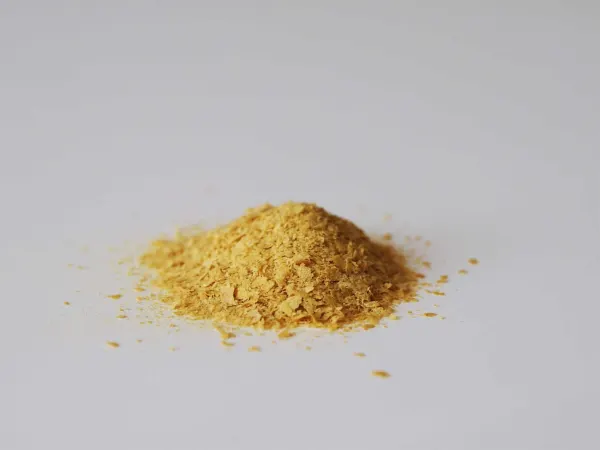Nutritional Yeast
Supplement
Age Suggestion
6 months
Iron-Rich
No
Common Allergen
No

When can babies eat nutritional yeast?
There is no official recommendation for when nutritional yeast may be served to babies, but that’s pretty common with processed foods. The available research suggests that nutritional yeast may be introduced as soon as your baby is ready to start solids, which is generally around 6 months of age.
What is nutritional yeast?
Nutritional yeast is the same strain of fungus as baker’s and brewer’s yeast, but it is dead, meaning that its fermentation and leavening properties are inactive. To make nutritional yeast, the fungus is added to a glucose-rich mixture, typically molasses and water, where it ferments and develops proteins. Once the yeast has matured, it is harvested, pasteurized, sterilized, and boosted with added nutrients before being dried and processed into flakes, granules, or powders.
Pungent and nutty, nutritional yeast is a beloved ingredient in vegan cooking, where it adds a cheese-like flavor in dishes. Nutritional yeast grew in popularity in the early 20th century thanks to savvy marketing that framed the yeast—a byproduct of distilling—as a health food supplement in the United States.
Videos
Is nutritional yeast healthy for babies?
In moderation. Nutritional yeast can be a healthy addition to a baby’s diet, especially in families that prefer vegan and vegetarian cooking. Brands vary in nutritional value due to the fortification process, but generally speaking, nutritional yeast offers plenty of B-vitamins, including B6, folate, and B12, plus it can offer a little fiber, protein, iron, and zinc depending on the brand. These nutrients are critical for development of your baby’s brain, nervous system, blood cells, and immune system. Note: nutritional yeast is made with beet molasses, and most of the world’s sugar beet production comes from genetically modified organisms.
It is important to note that different brands have different concentrations and types of nutrients, so read labels closely and adjust the serving size accordingly. For example, ¼ teaspoon of Red Star nutritional yeast has 0.67 micrograms of vitamin B12, which is slightly above the recommended daily intake for babies and slightly below the recommended daily intake for toddlers and preschoolers.
You may have heard that eating nutritional yeast can lead to yeast infections, however, there is very little evidence to substantiate this. Plus the strains of fungus in nutritional yeast are different than those that cause yeast infections.
Bottom line: A sprinkle of nutritional yeast on your baby’s meal once in a while can boost nutrition while introducing new flavors.
★Tip: Nutritional yeast should be stored in a cool, dark, dry place. Storing it in the refrigerator will extend its shelf life.
Is nutritional yeast a common choking hazard for babies?
No, though nutritional yeast tends to dry foods that it’s added to, which can make them difficult to swallow. Check out our age-appropriate serving suggestions, and, as always, stay near your baby during meals.
For more information, visit our section on gagging and choking and familiarize yourself with common choking hazards.
Is nutritional yeast a common allergen?
No, nutritional yeast is not considered a common allergen. However, it is possible to develop an allergy to saccharomyces cerevisiae, the source of nutritional yeast. In sensitive individuals, ingesting the yeast may worsen eczema and inhaling the powdered form of the yeast may trigger asthma symptoms.
As with introducing any new food, start by serving a small quantity on its own for the initial exposure, and if there is no adverse reaction, gradually increase the quantity over future servings. Although nutritional yeast is typically gluten-free, cross-contamination may exist, so read labels carefully.
How do you prepare nutritional yeast for babies with baby-led weaning?
Every baby develops on their own timeline, and the suggestions on how to cut or prepare particular foods are generalizations for a broad audience.
6 to 12 months old:
Sprinkle a pinch of nutritional yeast on top of cooked vegetables, eggs, and pasta, or on slippery foods like avocado to add some grip along with a boost of nutrition. To help your baby develop an interest and tolerance for the funky flavor, introduce nutritional yeast early (6 to 9 months) when your little one is more accepting of new foods.
12 to 24 months old:
Sprinkle a pinch of nutritional yeast on cooked foods as you wish. Nutritional yeast will add a cheese-like flavor to foods like beans, eggs, pastas, and sauces.
Written and reviewed by these specialists
J. Truppi, MSN, CNS
V. Kalami, MNSP, RD
S. Bajowala, MD, FAAAAI. (allergy section)
R. Ruiz, MD Board-Certified General Pediatrician and Pediatric Gastroenterologist
Expert Tips Delivered to Your Inbox
Sign up for weekly tips, recipes and more!
The content offered on SolidStarts.com is for informational purposes only. Solidstarts is not engaged in rendering professional advice, whether medical or otherwise, to individual users or their children or families. No content on this site, regardless of date, should ever be used as a substitute for direct medical advice from your doctor or your medical or health professional, nutritionist, or expert in pediatric feeding and eating. By accessing the content on SolidStarts.com, you acknowledge and agree that you are accepting the responsibility for your child’s health and well-being. In return for providing you with an array of content “baby-led weaning” information, you waive any claims that you or your child may have as a result of utilizing the content on SolidStarts.com.


